2009 Hyundai Sonata airbag
[x] Cancel search: airbagPage 10 of 340
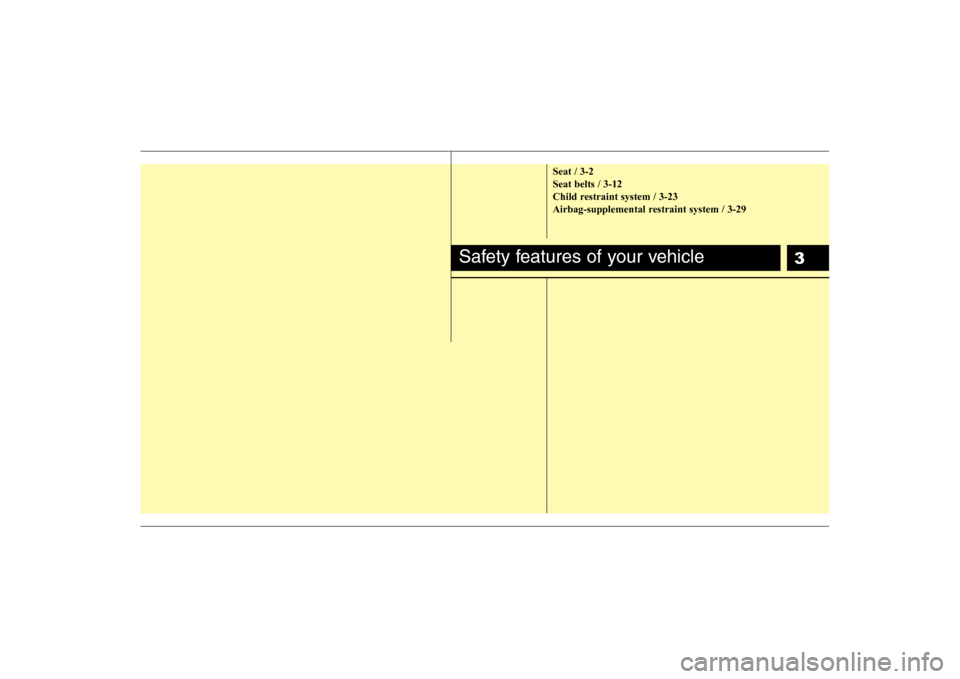
3
Seat / 3-2 Seat belts / 3-12
Child restraint system / 3-23
Airbag-supplemental restraint system / 3-29
Safety features of your vehicle
Page 32 of 340
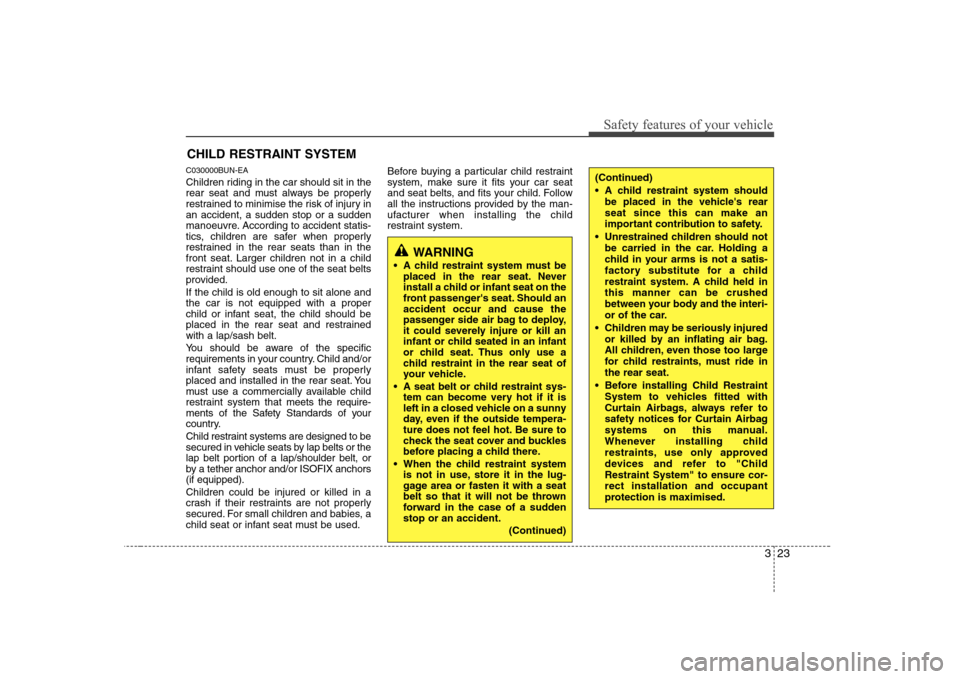
323
Safety features of your vehicle
CHILD RESTRAINT SYSTEM
C030000BUN-EA
Children riding in the car should sit in the
rear seat and must always be properly
restrained to minimise the risk of injury inan accident, a sudden stop or a sudden
manoeuvre. According to accident statis-
tics, children are safer when properly
restrained in the rear seats than in the
front seat. Larger children not in a child
restraint should use one of the seat belts
provided. If the child is old enough to sit alone and the car is not equipped with a proper
child or infant seat, the child should be
placed in the rear seat and restrainedwith a lap/sash belt.
You should be aware of the specific
requirements in your country. Child and/or
infant safety seats must be properly
placed and installed in the rear seat. You
must use a commercially available child
restraint system that meets the re quire-
ments of the Safety Standards of your
country.
Child restraint systems are designed to be
secured in vehicle seats by lap belts or the
lap belt portion of a lap/shoulder belt, or
by a tether anchor and/or ISOFIX anchors(if equipped). Children could be injured or killed in a
crash if their restraints are not properly
secured. For small children and babies, a
child seat or infant seat must be used. Before buying a particular child restraint
system, make sure it fits your car seat
and seat belts, and fits your child. Follow
all the instructions provided by the man-
ufacturer when installing the child
restraint system.
WARNING
A child restraint system must be placed in the rear seat. Never
install a child or infant seat on the
front passenger's seat. Should anaccident occur and cause the
passenger side air bag to deploy,
it could severely injure or kill an
infant or child seated in an infant
or child seat. Thus only use a
child restraint in the rear seat of
your vehicle.
A seat belt or child restraint sys- tem can become very hot if it is
left in a closed vehicle on a sunny
day, even if the outside tempera-
ture does not feel hot. Be sure to
check the seat cover and buckles
before placing a child there.
When the child restraint system is not in use, store it in the lug-
gage area or fasten it with a seat
belt so that it will not be thrown
forward in the case of a suddenstop or an accident.
(Continued)
(Continued)
A child restraint system shouldbe placed in the vehicle's rear seat since this can make an
important contribution to safety.
Unrestrained children should not be carried in the car. Holding a
child in your arms is not a satis-
factory substitute for a child
restraint system. A child held inthis manner can be crushed
between your body and the interi-
or of the car.
Children may be seriously injured or killed by an inflating air bag.
All children, even those too large
for child restraints, must ride inthe rear seat.
Before installing Child Restraint System to vehicles fitted with
Curtain Airbags, always refer to
safety notices for Curtain Airbag
systems on this manual.
Whenever installing child
restraints, use only approved
devices and refer to "ChildRestraint System" to ensure cor-rect installation and occupant
protection is maximised.
Page 43 of 340

Safety features of your vehicle
34
3
OED036100/H
1JBA3514/H
1JBA3522
Rear impact
Side impact
Rollover
(Continued)
No objects should be placed over
or near the air bag modules on
the steering wheel, instrument
panel, and the front passenger's
panel above the glove box,
because any such object could
cause harm if the vehicle is in a
crash severe enough to cause
the air bags to deploy.
Do not tamper with or disconnect SRS wiring or other components
of the SRS system. Doing so
could result in injury, due to acci-
dental deployment of the air bags
or by rendering the SRS inopera-
tive.
If the SRS air bag warning light remains illuminated while the
vehicle is being driven, have an
authorised HYUNDAI dealer
inspect the air bag system as
soon as possible.
(Continued)(Continued)
Air bags can only be used once –have an authorised HYUNDAI
dealer replace the air bag imme-
diately after deployment.
The SRS is designed to deploy the airbags only when the impact
is sufficiently severe and when
the impact is in the front or
frontal angle of the vehicle, and
will not deploy in side, rear or
rollover impacts. Additionally, the
airbags will only deploy once.
Thus, seat belts must be worn atall times.
Front air bags are not intended to deploy in side-impact, rear-
impact or rollover crashes. In
addition, front air bags will not
deploy in frontal crashes below
the deployment threshold.
(Continued)
Page 45 of 340
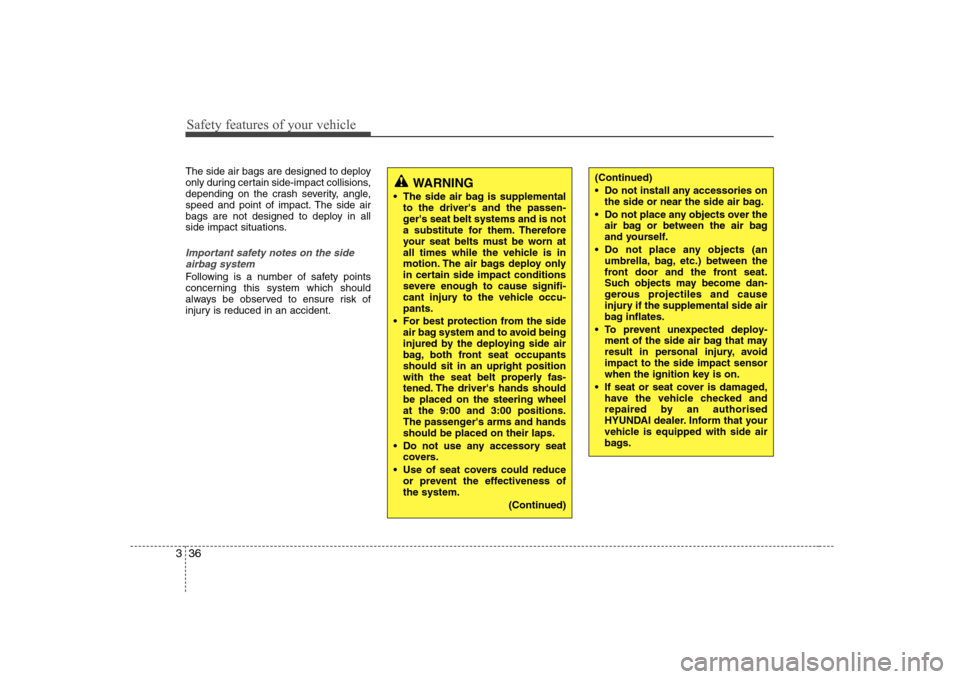
Safety features of your vehicle
36
3
The side air bags are designed to deploy
only during certain side-impact collisions,
depending on the crash severity, angle,
speed and point of impact. The side air
bags are not designed to deploy in all
side impact situations.
Important safety notes on the side
airbag system
Following is a number of safety points
concerning this system which should
always be observed to ensure risk of
injury is reduced in an accident.
(Continued)
Do not install any accessories on the side or near the side air bag.
Do not place any objects over the air bag or between the air bag
and yourself.
Do not place any objects (an umbrella, bag, etc.) between the
front door and the front seat.
Such objects may become dan-
gerous projectiles and cause
injury if the supplemental side air
bag inflates.
To prevent unexpected deploy- ment of the side air bag that may
result in personal injury, avoidimpact to the side impact sensor
when the ignition key is on.
If seat or seat cover is damaged, have the vehicle checked and
repaired by an authorised
HYUNDAI dealer. Inform that your
vehicle is equipped with side air
bags.WARNING
The side air bag is supplemental to the driver's and the passen-
ger's seat belt systems and is not
a substitute for them. Therefore
your seat belts must be worn at
all times while the vehicle is in
motion. The air bags deploy only
in certain side impact conditions
severe enough to cause signifi-
cant injury to the vehicle occu-pants.
For best protection from the side air bag system and to avoid being
injured by the deploying side air
bag, both front seat occupantsshould sit in an upright position
with the seat belt properly fas-
tened. The driver's hands shouldbe placed on the steering wheelat the 9:00 and 3:00 positions.
The passenger's arms and handsshould be placed on their laps.
Do not use any accessory seat covers.
Use of seat covers could reduce or prevent the effectiveness ofthe system.
(Continued)
Page 46 of 340

337
Safety features of your vehicle
C040700AFD-EA
Curtain air bag (if equipped)
Curtain air bags are located along both
sides of the roof rails above the front and
rear doors.
They are designed to help protect the heads of the front seat occupants andthe rear outboard seat occupants in cer-
tain side impact collisions.The curtain air bags are designed to
deploy only during certain side impact
collisions, depending on the crash sever-
ity, angle, speed and impact. The curtain
air bags are not designed to deploy in all
side impact situations, collisions from the
front or rear of the vehicle or in most
rollover situations.
Important safety notes for curtain
airbag systems
Following is a number of safety points
concerning this system which should
always be observed to ensure risk of
injury is reduced in an accident.
WARNING
Before installing child restraints, always refer to "Child Restraint System" to ensure correct instal-
lation and occupant protection ismaximised.
Make sure that the occupant does not have any body parts
(head, arms & legs) protruding
outside the restraining system. If
an inflating airbag was to strike
an infant child on the head, it may
cause serious injury.
(Continued)
(Continued)
Ensure the opening for theCurtain Airbag System remains
unobstructed at all times, so that
the airbags can inflate properly ifneeded.
The built in coat hooks should only be used for light weight
clothing, ensure that pockets are
free of any heavy or sharp
objects. When using coat hooks,
do not hang clothes on coat
hangers.
The space between the occupant and the curtain airbag must never
be occupied by children, passen-
gers or pets. Occupants should
never lean out or have any parts
of their body protruding from the
window whilst the engine is run-ning.
Do not move the sun visor out to cover the side window if there is
an item attached to it such as
garage door remote control,
pens, air fresheners or the like.
These objects may cause injury if
the Curtain Airbag is deployed.
(Continued)
OHD036125
OUN026090
Page 47 of 340
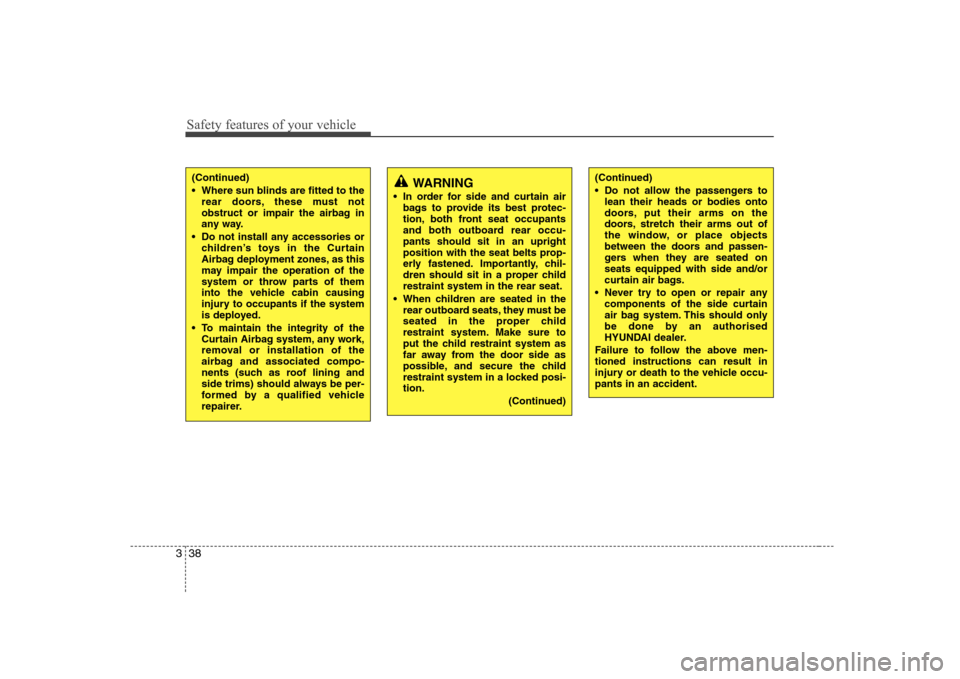
Safety features of your vehicle
38
3
(Continued)
Where sun blinds are fitted to the
rear doors, these must not
obstruct or impair the airbag in
any way.
Do not install any accessories or children’s toys in the Curtain
Airbag deployment zones, as this
may impair the operation of the
system or throw parts of them
into the vehicle cabin causing
injury to occupants if the system
is deployed.
To maintain the integrity of the Curtain Airbag system, any work,
removal or installation of the
airbag and associated compo-
nents (such as roof lining and
side trims) should always be per-
formed by a qualified vehicle
repairer.WARNING
In order for side and curtain air bags to provide its best protec-
tion, both front seat occupants
and both outboard rear occu-pants should sit in an upright
position with the seat belts prop-
erly fastened. Importantly, chil-
dren should sit in a proper childrestraint system in the rear seat.
When children are seated in the rear outboard seats, they must be
seated in the proper child
restraint system. Make sure to
put the child restraint system as
far away from the door side as
possible, and secure the child
restraint system in a locked posi-tion.
(Continued)(Continued)
Do not allow the passengers tolean their heads or bodies onto
doors, put their arms on the
doors, stretch their arms out of
the window, or place objects
between the doors and passen-
gers when they are seated onseats equipped with side and/or
curtain air bags.
Never try to open or repair any components of the side curtain
air bag system. This should only
be done by an authorised
HYUNDAI dealer.
Failure to follow the above men-tioned instructions can result in
injury or death to the vehicle occu-pants in an accident.
Page 98 of 340
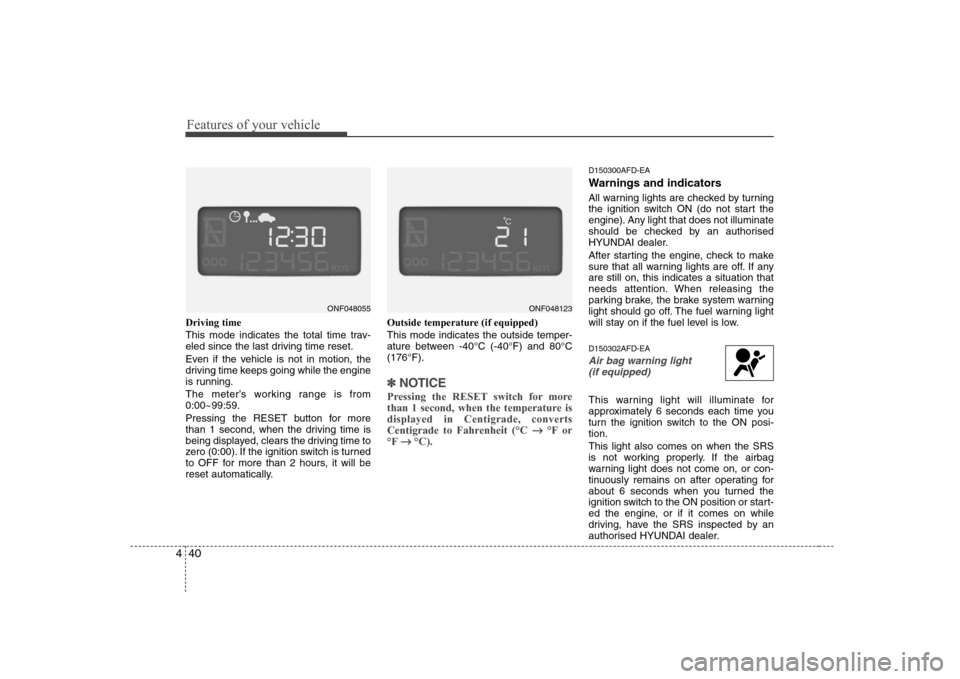
Features of your vehicle
40
4
Driving time
This mode indicates the total time trav-
eled since the last driving time reset.
Even if the vehicle is not in motion, the
driving time keeps going while the engine
is running.
The meter’s working range is from 0:00~99:59.
Pressing the RESET button for more
than 1 second, when the driving time is
being displayed, clears the driving time to
zero (0:00). If the ignition switch is turned
to OFF for more than 2 hours, it will be
reset automatically. Outside temperature (if equipped) This mode indicates the outside temper-
ature between -40°C (-40°F) and 80°C(176°F).
✽✽
NOTICE
Pressing the RESET switch for more
than 1 second, when the temperature isdisplayed in Centigrade, converts
Centigrade to Fahrenheit (°C �
�
°F or
°F ��
°C).
D150300AFD-EA
Warnings and indicators
All warning lights are checked by turning
the ignition switch ON (do not start the
engine). Any light that does not illuminate
should be checked by an authorised
HYUNDAI dealer.
After starting the engine, check to make
sure that all warning lights are off. If anyare still on, this indicates a situation that
needs attention. When releasing the
parking brake, the brake system warning
light should go off. The fuel warning light
will stay on if the fuel level is low. D150302AFD-EA
Air bag warning light
(if equipped)
This warning light will illuminate for
approximately 6 seconds each time you
turn the ignition switch to the ON posi-tion. This light also comes on when the SRS
is not working properly. If the airbag
warning light does not come on, or con-
tinuously remains on after operating for
about 6 seconds when you turned the
ignition switch to the ON position or start-
ed the engine, or if it comes on while
driving, have the SRS inspected by an
authorised HYUNDAI dealer.
ONF048123ONF048055
Page 301 of 340

Maintenance
58
7
Driver's side fuse panel
Fuse Fuse rating Protected component
SPARE 15A (Spare)
SPARE 15A (Spare) ETACS 10A BCM(Body Control Module), Sunroof control module, Electronic chrome mirror, Rheostat ESP 10A ESP module, Blower relay, Humidity sensor
C/LIGHTER 20A Cigarette lighter, Power outlet SPARE 15A (Spare)
TAIL RH 10A Illumination lights : License light, Right rear combination light, Headlight, Glove box light TAIL LH 10A Front fog light relay, Left : Rear combination light, Headlight
IONIZER 10A Headlight washer relay H/LP 10A DRL control module, Headlight relay, AQS and ambient sensor, PTC relay
WIPER 25A Wiper and washer A/CON 10A A/C control module A/BAG 15A SRS control module, Passenger's Airbag switch
P/OUTLET 20A Front accessory socket, Rear power outlet D/CLOCK 10A Digital clock, Audio, A/T shift lock control module, Power outside mirror and mirror folding, BCM, Audio
SAFETY PWR 25A Safety window module SPARE 15A (Spare)
ATM KEY LOCK 10A A/T shift lock control module P/WDW RR LH 25A Power window main switch, Left rear power window switch P/WDW RH 30A Power window main switch, Right power window switch